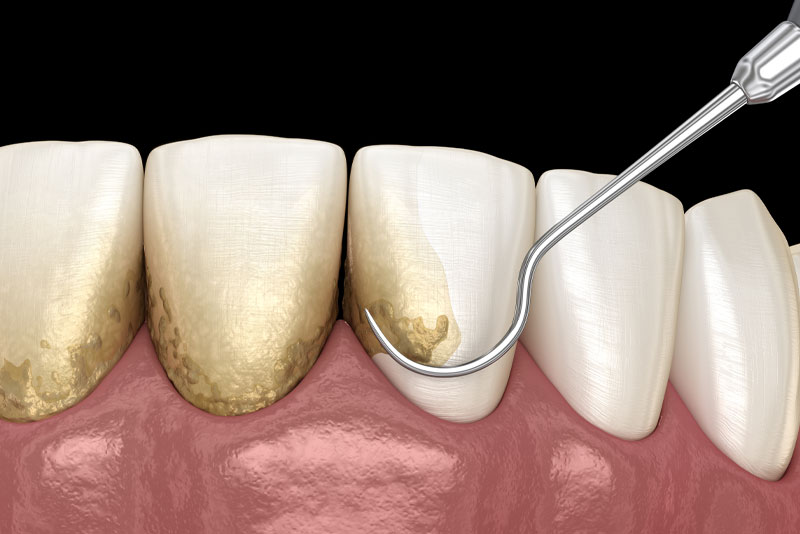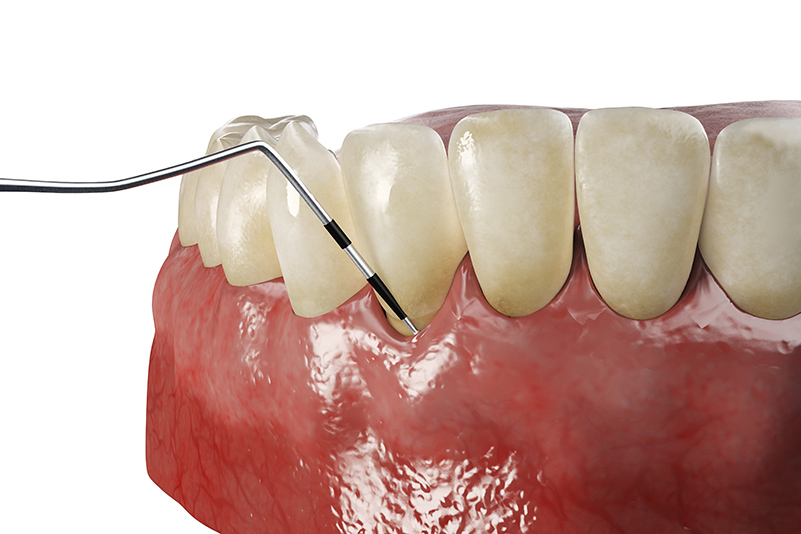
Periodontal disease occurs when bacteria that live below the gum line produce toxins which cause our bodies to destroy the bone that supports the teeth. There is no cure for periodontal disease. However, with early detection and timely treatment, we can help to stop the progression of this disease and prevent further bone and tooth loss.
Bacteria live within the plaque that accumulates in the mouth. When plaque is not removed properly, it can solidify into difficult to remove calculus, or tartar. The bacteria affect the gums by causing the tissues to pull away from the teeth, creating periodontal pockets. When periodontal disease is left untreated, it can cause irreversible bone and tooth loss.
Scaling and root planing is a nonsurgical periodontal treatment that is typically recommended when periodontal disease is diagnosed. Gingivitis is the first stage of gum disease, affects only the gum tissues, and is completely reversible if detected and treated early. If left untreated, however, it can progress into the deeper tissues and potentially cause bone and tooth loss. Many patients who have gingivitis or more advanced stages of periodontal disease often experience bleeding and sore gums when brushing, flossing, and eating.

Scaling and root planing—also called deep cleaning—is a targeted, non-surgical treatment for early to moderate gum disease. It begins with a local anesthetic to numb the area, and if needed, your provider may offer sedation for comfort. Using both ultrasonic tools and fine hand instruments, plaque and hardened tartar (calculus) are removed from below the gum line in a process known as scaling.
Root planing follows, where rough areas along the tooth roots are smoothed out. This makes it harder for bacteria to return and helps the gum tissue naturally reattach to the clean tooth surface. By reducing inflammation and encouraging reattachment, this procedure helps shrink periodontal pockets and stabilize oral health.
Periodontal disease occurs when bacteria that live below the gum line produce toxins which cause our bodies to destroy the bone that supports the teeth. There is no cure for periodontal disease. However, with early detection and timely treatment, we can help to stop the progression of this disease and prevent further bone and tooth loss.
Scaling and root planing treatment is most effective in the early stages of gum disease and can help to reduce periodontal pocket depths up to two or three millimeters on average.
Home care is critical for healing after a deep cleaning. Thorough brushing and flossing are essential to keep the mouth free of debris and bacteria. In many cases, your doctor may recommend an antimicrobial mouth rinse—such as chlorhexidine—to reduce bacterial growth during the healing phase. Patients are also strongly advised to avoid tobacco use, which can interfere with recovery and increase the risk of reinfection.
For best results, patients should be in generally good health and not recovering from any recent major surgeries. Following your treatment, mild sensitivity or tenderness is normal, but typically short-lived.
When performed early, scaling and root planing can reduce pocket depths by up to two or three millimeters and prevent the progression of gum disease—protecting both your gums and the bone that supports your teeth.

This non-surgical procedure removes plaque and tartar buildup below the gum line. Using hand instruments and ultrasonic tools, Dr. Chertok smooths the tooth roots so gums can reattach properly—helping to reduce pocket depth and stop disease progression.
A regular dental cleaning focuses on removing plaque above the gum line. Scaling and root planing goes deeper—cleaning below the gums to treat early-stage periodontal disease and prevent bone and tooth loss.
Your doctor may use ultrasonic scalers and fine hand instruments to break up hardened tartar under the gums. Smoothing the root surfaces encourages gum reattachment and lowers inflammation caused by bacteria.
Most patients experience mild soreness or sensitivity for a few days. Proper brushing, flossing, and possibly a chlorhexidine rinse are important for healing. Smoking should be avoided, as it can delay recovery and increase infection risk.
Bleeding gums are a common early sign of gingivitis or periodontal disease. Bacteria irritate the gum tissue, causing inflammation and bleeding. Scaling and root planing removes the source of infection and helps restore gum health.
Untreated gingivitis can progress into deeper gum disease, creating pockets that lead to bone and tooth loss. Early treatment like scaling and root planing can reverse damage and protect your smile.
Yes. Dental professionals agree that when done early, scaling and root planing can prevent tooth loss by reducing bacteria and inflammation and allowing gums to reattach to your teeth.
Gum disease has no cure, but early intervention can stop it from progressing. Treating it early with scaling and root planing helps avoid more invasive procedures down the line.
Success depends on excellent home care. Daily brushing, flossing, and avoiding tobacco, along with follow-up cleanings, help keep your gums healthy and prevent the return of bacteria.
Simply contact Dr. Keith Chertok’s office in Berkeley, CA. He’ll assess your gum health and determine if this deep cleaning procedure is the right step toward protecting your teeth and gums.
